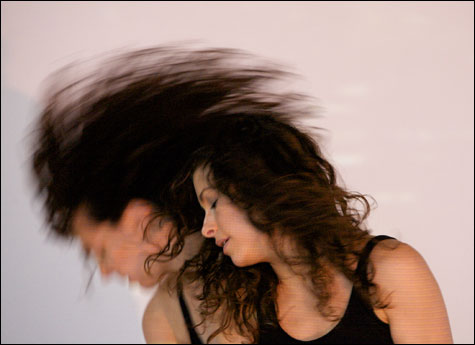
WARP Somewhat encumbered by scenic elements that all seem to reflect or conceal the nine women and their inner selves. |
At the beginning of Between Blood & Bone, a man and a woman stand at opposite sides of an empty space. A few minutes or a lifetime later, they're curled together on the floor, wrapped in the tightest possible embrace. The dance that carries them from alienation to dependency is an excerpt from the 2003 evening-length Apokalypsis, by Diane Arvanites and Tommy Neblett, co-directors of Prometheus Dance, part of the program they presented at the Institute of Contemporary Art last weekend.
Arvanites and Neblett are carrying on the tradition of expressive modern dance, the idea that movement can be not just a physical act but a sign of deeper human experience. In their Blood & Bone duet, the choreographers approach each other, their earthbound steps stained with the folklike sorrows of a score by Greek composer Eleni Karaindrou. Once they make contact, they seem unable to break it, and they slowly meld from one shape to another. You can't tell when either switches over from being the one who supports to the one who's being supported. They don't act out passion or fear, or engage in theatrical tricks, but with their eyes, their tactile hands, their whole bodies, they convey what goes on in a partnership.

On a bigger scale but still using only Arvanites's choreographed movement, Tabula Rasa (2005) looks at the interrelations of nine women. Although they're dressed alike, one seems to be the central figure, sometimes joining with the others, sometimes huddled at the center of their running circles. They all dance variations on a few movement themes, to Arvo Pärt's variations for strings and percussion. Eventually the central woman is running circles around her huddled antagonist companions. The dance may have psychological overtones, but the evolution of the group patterns is interesting in itself.
The new work by Arvanites and Neblett, WARP, to a commissioned score by John Kusiak, seems somewhat encumbered by an ever-present array of scenic elements: four rectangular panels mounted on rolling frames, five panels above the space showing video projections, and a strip of shiny white mats stretched across the floor downstage. They all seem to reflect or conceal the nine women and their inner selves.
Four women confront the rolling screens, their backs to the audience. Four other women double them behind the screens, sometimes invisibly moving the screens, sometimes appearing in silhouette or poking out a hand or a foot. Later the screens glide through the space in choreographed diagonals of their own, as women run and roll among them. Still later, they're arranged into a luminous box, and though one woman is dancing inside it, we catch only glimpses of her through the corners. In another scene, the screens are pushed together with a woman sandwiched between them.
All this maneuvering of the screens was beautifully coordinated by the dancers, but the rest of the movement seemed low-key and not very inventive. Maybe the idea of reflection is itself a limitation. Often the women worked in face-to-face pairs, or hovered behind a partner like commanding but distrusted alter egos.
Five women knelt in front of the shiny white carpet downstage — the sound of water running accompanied this — and in unison they peered down, as if looking into a stream. With a slow series of moves they seemed to be scooping up water, admiring themselves, lounging with their heads in the water and their hair spread out.
As the scenes changed, the women paced impassively through the space, or ran for their lives. Then the music moved into a two-note ostinato that reminded me of the snow scene in Petrouchka, and the women scudded into the space as if blown by a wind. Over the ostinato, a jazzy rhythm began, and for a moment I thought a celebration was in progress, but the dance ended in a growing darkness, with one woman coming forward and the others seated in a row, backs to the audience, hugging their knees.